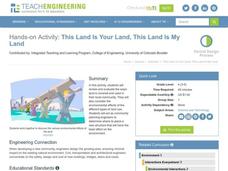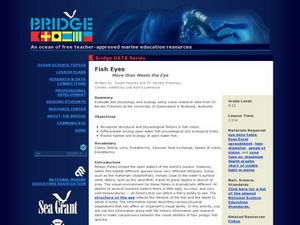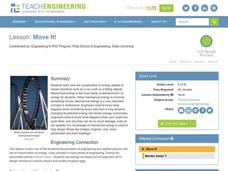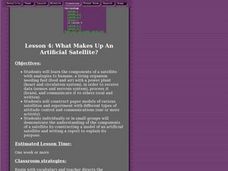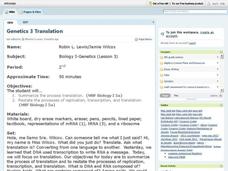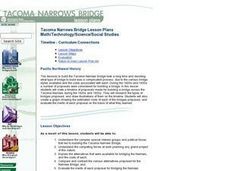Curated OER
How Should Our Gardens Grow?
Students examine different types of land use by humans and evaluate the ways land is used in their local community. They also consider the environmental effects of the different types of land use. Students assume the role of community...
Curated OER
This Land Is Your Land, This Land Is My Land
Students review and evaluate the ways land is covered and used in their local community. They consider the environmental effects of the different types of land use. Students act as community planning engineers to determine where to place...
Curated OER
Fish Eyes - More than Meets the Eye
Inform your class about the adaptations in fish eyes: cones, lens size, endothermy, and speed of vision. The adaptations are related to diving behavior. Junior marine scientists compare the adaptations of four different fish species to...
Curated OER
Environment: Wild Wind Direction
Students examine the different types of wind patterns. Using common materials, they construct weather vanes to measure and record wind direction over a two-week period. After analyzing the data, they draw conclusions about the...
Curated OER
Catering Middle-School Science: Monomers, Polymers, and Macromolecules
Students investigate foods. In this biology lesson plan, students will conduct testing on different types of foods as they learn about different molecules that make them up. Students will also learn about the shapes of the molecules.
Curated OER
Move It!
Students observe a demonstration presented by the teacher covering different types of energy. They participate in an experiment where they study numerous physics vocabulary words and visit websites that demonstrate examples of these...
Curated OER
Diatom Ooze
Young scholars explore seafloor sediment. In this ocean environment lesson, students describe the characteristics of different types of seafloor sediment and oozes. They compare and discuss locations of sediments and oozes by plotting...
Curated OER
Types of Things
Students explore the differences between man-made and natural objects. In this lesson designed to compare properties of objects, students differentiate between natural and man-made objects and complete an activity designed to show what...
Food a Fact of Life
Getting to Grips
Fruit fusion or dippy divers, anyone? Here's a delicious way to introduce young cooks to aspects of safe food handling and the use of food handling tools. Groups create fruits and/or vegetable salads to share with the class.
Curated OER
What Makes Up An Artificial Satellite?
Students discover the components of a satellite using analogies to humans in a class discussion and participate in an activity in which they construct a paper model of a satellites and experiment with different types of attitude control...
Curated OER
Kinds of Maps
In this map worksheet, students match a set of descriptions with the names of different types of maps and answer true/false questions and short answer questions about using maps.
DiscoverE
Human Arch
Sometimes, we all need somebody to lean on. Scholars create a human arch by leaning against each other. They consider different approaches to making the arch sturdier and stronger.
Curated OER
Raw Seafood ~ On the Half Shell
The topic is fascinating, but there is not much for learners to do here. Food borne illness has always been a problem for humans to face, and here, data from the Center for Disease Control is analyzed. Learners look at the number of...
Curated OER
Genetics 3 Translation
Ninth graders first summarize the process of translation, and then they identify and restate the processes of DNA replication, transcription, and translation in their own words. They also define the purpose of each and identify what the...
Curated OER
Gone With The Wind
Students review the different types of natural disasters. As a class, they examine how people and communities deal with weather disasters. They compare and contrast how two communities respond to a tornado or hurricane. They present...
Curated OER
The Future
This teacher guide provides several ideas for how to structure a unit on the futur simple. Start by having your class read the short passage provided about Google. As they read, pupils should categorize verbs by type to highlight...
CK-12 Foundation
Area and Volume of Similar Solids: Similar Solids
Five questions make up an interactive designed to boosts knowledge of area and volume of solid figures. Question types include multiple-choice, true or false, and fill-in-the-blank. A scale model changes measurement to provide a visual...
Curated OER
Surveys and Graphing
First graders survey different classrooms to determine types of products students would like to see sold at school, and create graphs based on survey results.
Curated OER
Bridging the gap between the U.S. and Cuba
Eleventh graders examine the events that led to the strained relationship between Cuba and the United States. In this US History lesson, 11th graders create an illustrated timeline of Cuba-U.S. relations. Students write an...
Curated OER
Tacoma Narrows Bridge
Students, in groups, create a profile of different Pacific Northwest explorers. They develop PowerPoint presentations and maps to showcase their findings.
Curated OER
Galloping Gertie
Middle schoolers read a poem and are to write another poem using the words given. They are also to develop a monument and narrative of the bridge and its collapse.
Curated OER
Geography: Water, Water Everywhere
Students discuss flooding and its causes. They view a Powerpoint presentation about floods and prevention methods. After creating a model with clay and pans, they investigate river behavior in various terrains with different amounts of...
Curated OER
Timeline - Curriculum Connections
Students research a timetable for the building of the Tacoma Narrows Bridge. After the research is completed, students construct a graph and come up with different proposals for the building of the bridge.
Curated OER
Crossing the Narrows: Idea & Dream,...to 1937
Students decide which group they would like to be a member of discussing the Tacoma Narrowns Bridge. Each group researches the same questions but have different answers depending on the group they are in.

